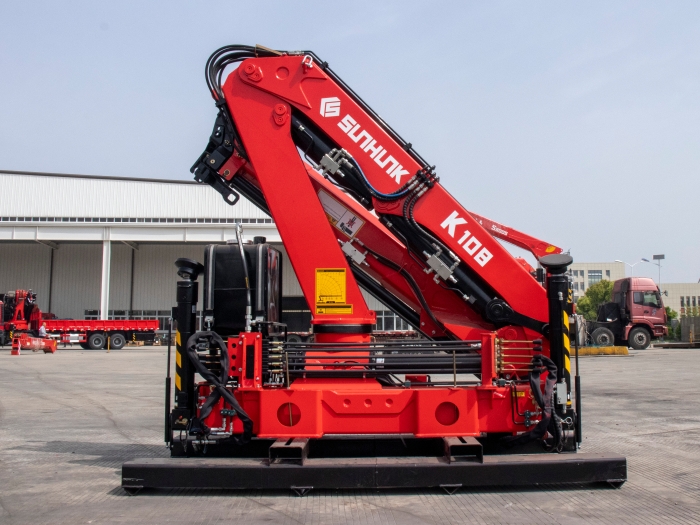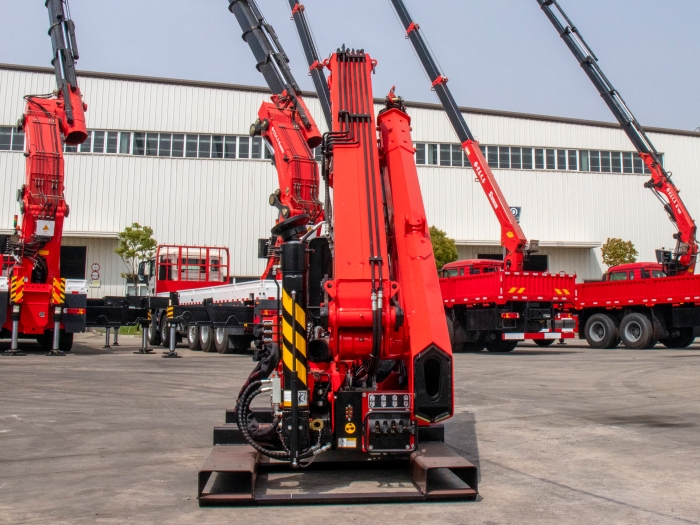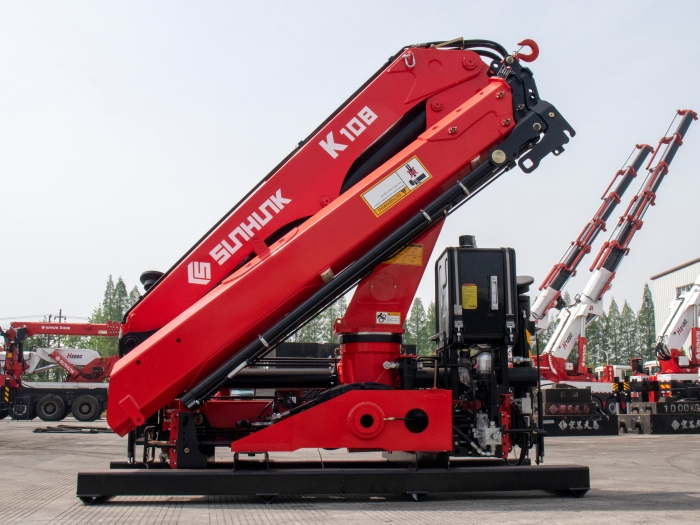- PRODUCTS
- SOLUTION
- SERVICE
- NEWS
- ABOUT US
Selecting the ideal loader crane involves evaluating lifting capacity (1-60 tons), reach, fuel efficiency, and integration with logistics systems for optimized operation.
Loader cranes, also known as tr
uck-mounted cranes, play a pivotal role in the logistics industry, enabling the efficient handling and transportation of goods. Their primary function is to load and unload heavy materials from vehicles, thereby facilitating a smooth flow in the supply chain process. The versatility and mobility of loader cranes make them an indispensable asset for various applications, ranging from construction sites to warehouses and manufacturing facilities.
Loader cranes excel in tasks that require precision and flexibility. Equipped with hydraulic systems, they can lift heavy objects directly onto the bed of a truck or trailer, significantly reducing the need for additional handling equipment. This capability not only speeds up the loading process but also minimizes labor costs and enhances safety on site. Loader cranes are particularly effective in environments where space is limited, offering a compact lifting solution that can maneuver in tight spaces with ease.
Moreover, these cranes contribute substantially to the efficiency of the logistics chain by ensuring the rapid deployment of goods. For instance, a loader crane with a lifting capacity of up to 30 tons can expedite the transport of bulky items, such as construction materials, industrial equipment, and large containers.
Loader cranes come in various configurations, each designed to meet specific operational requirements. The two most common types are the folding arm crane and the straight arm crane.
Folding Arm Cranes: Also known as knuckle boom cranes, these models are celebrated for their flexibility and compact design. The articulating arm folds into a small space when not in use, making it ideal for tasks in congested areas. Additionally, folding arm cranes can be equipped with various attachments, like buckets and pallet forks, enhancing their versatility. Their lifting capacity typically ranges from 1 ton to more than 30 tons, catering to a broad spectrum of loading tasks.
Straight Arm Cranes: These cranes feature a telescopic boom that extends straight out, offering exceptional lifting heights and reach. They are particularly suitable for applications requiring high lifting capacity and stability, such as the transportation of heavy industrial machinery. Straight arm cranes can lift loads of up to 60 tons, depending on the model and configuration.
Furthermore, modern loader cranes often come with remote control operation, allowing operators to maneuver the crane from a safe distance. This technology not only improves operator safety but also enhances precision in load handling.

Selecting the appropriate loader crane depends on various factors, including lifting capacity, reach, application, and environmental considerations. For instance, a folding arm crane might be the preferred choice for urban construction projects where space is a constraint, whereas a straight arm crane would be more suitable for industrial applications requiring high lifting capacities.
In conclusion, loader cranes are an essential component of the logistics industry, offering unmatched flexibility, efficiency, and safety in material handling. By understanding the basic functions, applications, and types of loader cranes, businesses can make informed decisions that optimize their logistics operations. Whether it's a folding arm crane for urban projects or a straight arm crane for industrial applications, the right loader crane can significantly enhance the productivity and efficiency of logistics tasks.
For more detailed specifications and models, consulting with manufacturers and comparing the features of different cranes is advisable. This approach ensures that you select a crane that perfectly matches your logistical needs and operational environment.
When selecting a loader crane, understanding the key technical specifications is crucial to ensure it meets your logistical requirements. Three primary aspects stand out: maximum lifting capacity, working range, and loading efficiency.
The maximum lifting capacity, often measured in tons, indicates the heaviest load the crane can handle. Loader cranes vary widely in their capabilities, ranging from smaller models capable of lifting 1 ton to larger cranes designed for 60 tons or more. This specification directly influences the type of materials and goods the crane can transport, making it a critical factor in the selection process.
The working range, which includes the crane's reach and lifting height, determines how far and how high the crane can move loads. A crane with a long reach is essential for projects where materials need to be transported over considerable distances or obstacles. Similarly, a high lifting height is crucial for tasks that involve stacking goods or materials vertically.
Loading efficiency refers to the speed and accuracy with which the crane can load and unload materials. This parameter is influenced by the crane's design, such as its boom type (folding arm or straight arm) and control system (manual or remote-controlled). Cranes with advanced hydraulic systems and precision controls can significantly enhance loading efficiency, reducing downtime and increasing throughput.
Evaluating a loader crane's operational efficiency and cost-effectiveness involves considering both its performance and the ongoing expenses associated with its use, such as fuel efficiency and maintenance costs.

Fuel efficiency is a key consideration, especially for cranes that operate for extended periods. Modern cranes are designed with fuel-efficient engines that minimize fuel consumption without compromising performance. For instance, a crane that consumes 10 liters of fuel per hour under full load conditions is more cost-effective than one that consumes 15 liters for the same workload.
Regular maintenance is essential to ensure the crane operates reliably and safely. The cost of maintenance can vary significantly depending on the crane's complexity and the availability of parts and service. Cranes designed with ease of maintenance in mind typically incur lower overall operating costs.
Loader cranes offer various configuration and customization options to meet specific logistical needs, including special attachments and tools.
Attachments such as pallet forks, buckets, and grabs allow the crane to handle a wide range of materials, from bulk goods to specialized equipment. Selecting the right attachments can greatly expand the crane's versatility and application scope.
Customization options might include the installation of additional safety features, enhanced control systems for precision operations, or modifications to the crane's structure to suit particular working environments. For instance, cranes operating in maritime environments might require corrosion-resistant coatings and components.
In conclusion, selecting the right loader crane involves a detailed analysis of its technical specifications, operational efficiency, and customization options. By focusing on these key aspects, businesses can ensure they invest in equipment that not only meets their current needs but also offers adaptability for future requirements. Understanding these factors in depth enables informed decision-making, ensuring the selected crane delivers the best balance of performance, efficiency, and cost-effectiveness for the specific logistical challenges at hand.

Integrating loader cranes with existing logistics management systems and technological platforms is essential for maximizing efficiency and leveraging automation and digital functionalities. This integration enables real-time tracking of cargo movements, enhances operational visibility, and improves decision-making processes.
Loader cranes equipped with GPS tracking and IoT (Internet of Things) sensors can seamlessly integrate with logistics management systems. This integration allows for the monitoring of crane movements and load statuses in real-time, facilitating efficient scheduling and dispatching. For example, a crane that transmits its location and load status every minute provides logistics managers with up-to-date information, ensuring timely and accurate delivery schedules.
Automation and digital features such as remote control operations and predictive maintenance algorithms further enhance the crane's integration capabilities. Cranes that can be operated remotely or programmed with automated routines for repetitive tasks reduce the need for manual intervention, thereby increasing safety and productivity. Additionally, cranes with onboard diagnostics and IoT connectivity can predict maintenance needs, minimizing downtime and extending the equipment's lifespan.
Ensuring efficient and safe operation of loader cranes requires comprehensive operator training and regular maintenance guidance. These aspects are critical for preventing accidents, reducing wear and tear, and ensuring the crane operates at its full potential.
Effective operator training programs cover the crane's operation, safety protocols, and emergency procedures. For instance, a training module that includes both theoretical lessons and practical exercises ensures operators are well-versed in handling the crane under various conditions. Training should also emphasize the importance of pre-operation checks and load balancing techniques to prevent tipping incidents.
Regular maintenance is vital for the crane's reliability and longevity. A maintenance schedule that outlines daily, weekly, and monthly checks, along with detailed procedures for common issues, helps operators and technicians keep the crane in optimal condition. For example, a maintenance checklist might include engine oil and hydraulic fluid levels, condition of the boom and outriggers, and inspection of the hook and wire rope.
In summary, the integration of loader cranes with logistics management systems and the emphasis on automation and digitalization play a pivotal role in enhancing operational efficiency and safety. Additionally, comprehensive operator training and adherence to a structured maintenance program are indispensable for ensuring the crane's performance and longevity. By focusing on these areas, businesses can achieve a harmonious blend of technology, human expertise, and proactive maintenance, driving productivity and safety in their logistics operations.